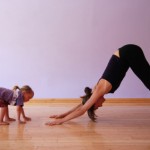 By Faye Martins
By Faye Martins
Yoga is an activity that doesn’t discriminate against the young, old, injured, or disabled. Everyone can find a way to succeed while practicing yoga. While there are always necessary precautions to avoid injury, there are no “right” or “wrong” ways to perform yoga poses. As each person finds what feels best for them, they will begin to realize yoga’s wonderful benefits. Sometimes when we practice yoga, we must look at the bigger picture to find an overall sense of peace and wellness, increased strength and flexibility, and reduced stress. How we get to those end results isn’t as important as actually getting there.
It’s helpful to keep this bigger picture in mind when teaching kids’ yoga classes. Instructors can expect an entirely different atmosphere than an adult yoga class. Kids are vibrant, noisy, and full of curiosity. When you are teaching a class full of kids, you will have to modify things a bit to get them engaged, and to give them a positive experience with yoga.
One of the differences between an adult yoga class and a kids yoga class is the noise level. Adult classes are often quiet environments, with soothing music piping through the background, the yoga instructor’s voice giving cues, and an occasional comment or question from a student. While you can certainly strive to provide a calming environment, a children’s yoga class will be a bit more noisy than adult classes. In fact, it might behoove the instructor to encourage a little bit of noise, in order to engage the children with the poses. Incorporating noises with each pose, especially animal and nature-related ones, will help kids remember the poses and engage them with each pose. Instructors can also lead the class with stories that incorporate poses, while asking the students to contribute to the dialogue.
Kids’ yoga instructors can also expect a bit more movement in the class. While most adults stay planted on their mats for the duration of the class, kids want to move around the room. Let them move from mat to mat, performing a different pose on each mat, or play other games where they must move about.
Be flexible with the yoga class format while teaching kids. Let the kids have as much fun as they are willing to have. Yoga teachers should keep the class loosely structured, allowing it to flow in any direction the kids take it. For example, if they are super engaged in a silly story, tell another one, even if it doesn’t quite follow your plan.
© Copyright – Aura Wellness Center – Publications Division
To see our selection of Yoga teacher training courses, please visit the following link.
https://aurawellnesscenter.com/store/
Click here too see our online Yoga Nidra teacher training course.
Are you an experienced teacher looking for YACEP credits or continuing education?
Subscribe to Our Newsletter for Special Discounts and New Products
Related Resources
52 Essential Principles of Yoga Philosophy to Deepen your Practice
by Rina Jakubowicz.
A Relaxing Way to De-stress, Re-energize, and Find Balance
by: Gail Boorstein Grossman.
YOGA: THE PATH TO HOLISTIC HEALTH
by B.K.S. Iyengar
TEACHING YOGA: Essential Foundations and Techniques
By Mark Stephens
Yoga and Meditation for Less Violent Children
Best Meditation Techniques for Children
Changing Yoga to Fit the Needs of Children
Are Social Skills Enhanced in Children’s Yoga Classes?

Kids are vibrant, noisy, and full of curiosity. So while teaching kids a teacher should be flexible with the yoga class format. Thanks for good article.
Yoga teachers should keep the class loosely structured, and should make it enjoyable for the kids. Nice article.